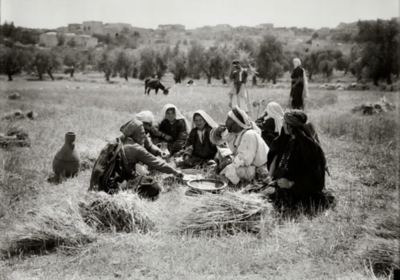When I was asked to write the book Macs in the Ministry, I was tasked with showing how Mac applications like iLife and iWork could be used in a ministry setting. So I had to create a series of hands-on projects which the reader can complete using the materials supplied on the accompanying DVD. When it came to showing how to use iMovie, I created a brief promotional video introducing a preaching series about the story of David and Bathsheba in 2 Samuel 11.
The video began with a panoramic shot of Jerusalem taken from the PhotoGuide. It was a great shot, but there was one problem: if you looked closely, you could see several huge construction cranes on the horizon! The presence of modern construction equipment kind of shatters the illusion of an ancient city, so I had to resort to a few tricks to minimize it. I used the Ken Burns effect to move the viewer’s eye away from the crane, applied an aged appearance to the photograph, and used an aging film video effect. All in all, it conveyed the feel I was going for, but using a modern photograph to depict an ancient city was not without its challenges.
Now, what if you could travel back in time to show the lands of the Bible before the rise of modern cities? As late as a hundred years ago, the land of Israel still looked much as it had for the preceding two thousand years. Wouldn’t it be great if we had photographs of Biblical sites as they looked even as late as the early twentieth century?
As a matter of fact, we do have such photographs—thousands of them!
Back in the late 1800’s, a group of Americans traveled to Jerusalem to establish a kind of religious commune that eventually became known as the “American Colony.” The story of that community, which was led by the author of the famous hymn, It Is Well With My Soul, is a strange and fascinating one. The American Colony supported itself in various ways, including through the sale of photographs to tourists, news agencies, publishers, etc. These photographs are an absolute treasure trove which was eventually donated to the Library of Congress and made available to the public. Yet like most treasure troves, finding and accessing the right treasure involved a great deal of work. Thankfully, Todd Bolen of BiblePlaces.com has sifted through this enormous collection of photographs and put it together in a usable form. He has also graciously allowed us to make this collection available in Accordance.
The American Colony and Eric Matson collection is a massive (1.4GB) Accordance module containing more than 4,000 historic photographs of the Holy Land and its people. It is fully searchable, and its images will be included any time you use the Search All window to search by Caption. Once you find an image you like, you can drag its thumbnail onto a Keynote or Pages drop-zone to include it in your slide show or document. The module also includes a fascinating introduction by Todd Bolen which delves into the history of the collection and the people behind it. In fact, Mr. Bolen describes the value of this collection far better than I can in this article. The article also includes numerous sample photographs from the collection, so you can see how beautiful these photos really are.
If you’re at all interested in teaching or illustrating the world of the Bible in a classroom or church setting, you owe it to yourself to begin exploring this incredible collection of historic photos. I promise that you’ll never have to worry about modern construction equipment littering the skyline of these photos!



